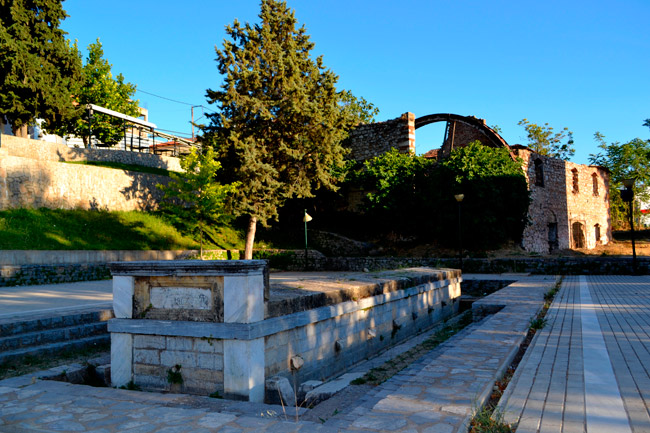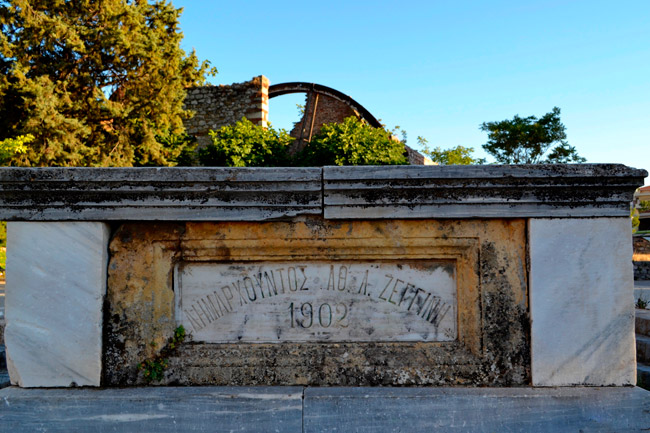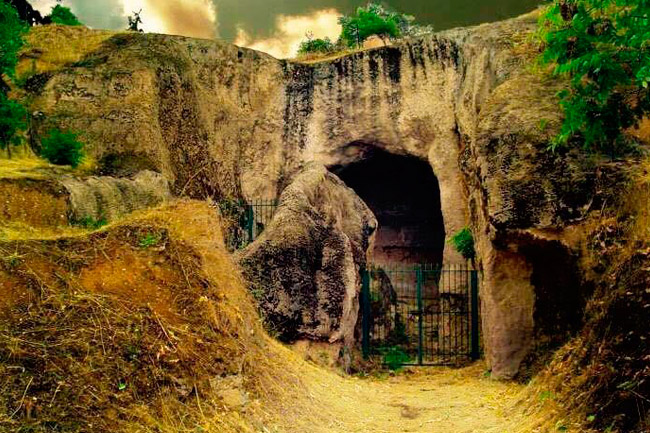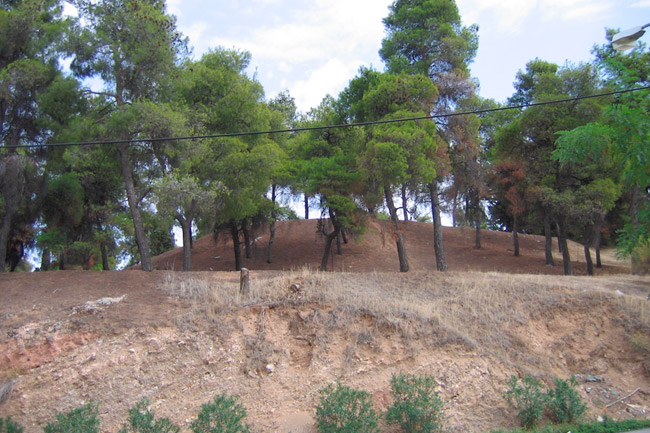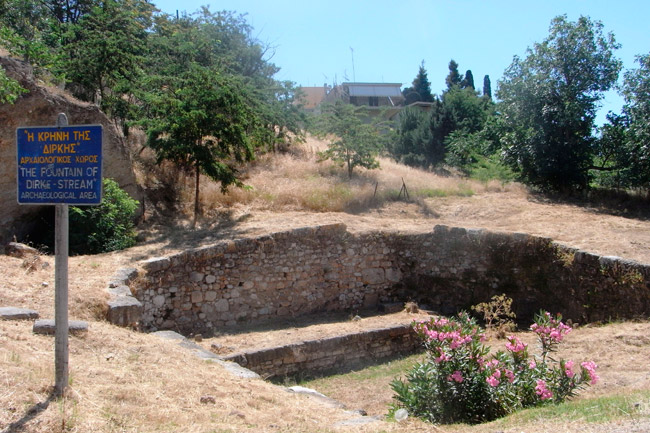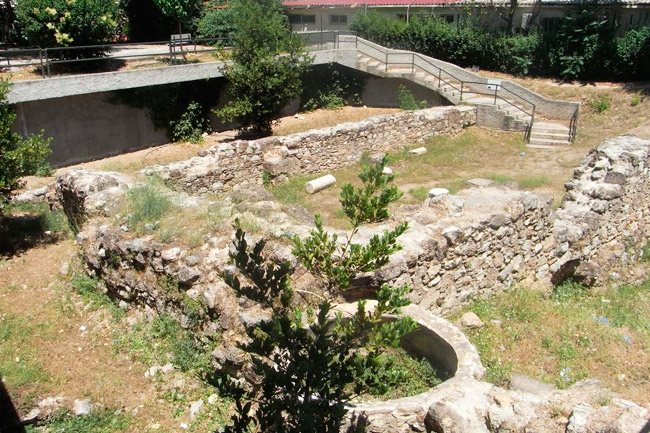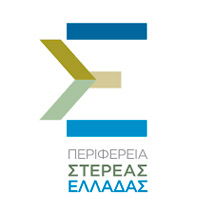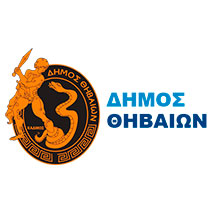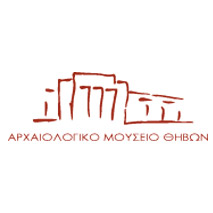Mycenaean Palace Kadmeion
The Mycenaean Palace, or Kadmeion, dates from the 13th century BC and is located almost centrally on the acropolis. The palace was decorated with frescoes and clay tablets in Linear B and amphorae have been found. The palace was destroyed by fire in around 1200 BC.
“Kadmeio”
At the centre of the acropolis of Kadmeia, in the heart of the modern city, there are the ruins of a building that, for its time, was magnificent. It is known as the Kadmeio, a large independent construction with many rooms and corridors designed for work and storage. These housed some of the most important workshops in the city’s Mycenaean palace, producing miniatures and items and jewellery from lapis lazuli, agate, quartz and gold, materials that came from as close as Thebes to as far away as Afghanistan. The same building housed a variety of other items, including large stirrup jars, which came to Thebes from Crete, full of oil.
“The Treasure Room”
The palace’s treasure room, or treasury occupies the north-east corner of the central complex of the Mycenaean palace of Thebes, which extends beneath the city’s central square. Excavations have uncovered the north and east walls of the room, which were built with large stone blocks to a height of 2.20m. It was at this height that the brick roof of the building began. The site was given its name because it was here that they stored precious items and jewellery of gold, lapis lazuli, agate and ivory, as well as a unique hoard of imported cylinder seals of Assyrian, Hittite, Hurrian, and Cypriot origin. A thick wall separated the ‘Treasury’ from the ‘Room with the Jars’, which took its name from the clay jars that were found there. It is under today’s Antigone Street. The clay tablets and seals in Linear B that were found in these two spaces show that a significant part of the administration of the Mycenaean palace at Thebes was run from here.
“The Armoury”
In the eastern part of the acropolis there is the building complex of the Armoury, which was an extension of the central complex of the palace. The rooms of this complex were used as storerooms for armaments, harness and bronze tools and utensils, storage areas for ivory, weighing of raw materials and also for the storage of stone tablets which were records of the economic activities of the palace.
Source: https://www.mthv.gr/
Temple of Ismenius Apollo
One of the most important temples of ancient Thebes was the sanctuary of Ismenios Apollo, on the homonymous hill southeast of the ancient city. The hill was used as early as the 15th century BC, as it was the site of one of the three large cemeteries of carved chamber tombs of Mycenaean Thebes.
Later, the famous temple was built there, the history of which has three successive temples built in this area during antiquity. The first one was built around the end of the 8th century BC and after its destruction it was replaced in Archaic times by another temple in Doric style, which was preserved until the beginning of the 4th century BC. Then a third temple was built, a Doric pavilion, which was probably never completed. The remains of the foundation, which can be seen today at the top of the hill, belong to this temple. According to Pausanias, at the entrance to the sanctuary there were statues of Hermes and Athena, which tradition attributed to the great sculptors Phidias and Scopas. In the sanctuary there were many dedications, mainly statues and tripods with votive inscriptions. Later the hill was used as an early Christian and Byzantine cemetery with built tombs that were in use until the 12th century AD.
Source: https://www.mthv.gr/
Amphion (Common tomb of the Dioscuri Amphion and Zethus)
Prehistoric tomb of Amphion
The tomb of Amphion, with a maximum height of 2 metres and a diameter of 21 metres, was built around 2600-2400 BC on the top of the natural hill of Amphion. It is conical in shape and consists of two lower layers of soil and an upper layer covered with soil and rectangular raw bricks of various sizes. The tomb covered an important earlier cemetery located on the top of the hill of the same name and dates back to the first quarter of the 3rd millennium. The extent of this cemetery is still unknown, and it is also unknown whether, apart from the graves, the tomb created there also covered some building remains, as is the case at Lerna, but also in the corresponding case of the hill of the Museum. The brief rescue excavation, however, carried out by the 9th EKPA in 2007 just under the tomb, brought to light three chamber tombs dug into the natural rock of the hill, as well as a shallow excavation where a woman with a baby in her arms had been buried.
At a later stage, either in the times of the next period following the construction of the tomb (2300-2000 BC) or during the Middle Bronze Age (2000-1700 BC), the top of the brick tomb of Amphion was dug to build a monumental box-shaped tomb, which received one or more burials with rich grave goods. The precise chronological connection between the tomb and the burial mound is not clear, as the burial mound was found already damaged, perhaps from antiquity, while the gold jewellery that was recovered from outside it is exactly what slipped out of the smugglers’ hands. However, the whole of the tomb and the impressive size of the tomb in its centre would have been an important and special point of reference for the inhabitants of Thiva since prehistoric times, a kind of monument-heroon.
Source: https://www.mthv.gr/
Chamber tombs of Oedipus’ children
In Thebes, the dead from the 16th century BC were buried outside of Kadmeia on the neighbouring hills of Agia Anna-Kolonaki, Kastellia and Isminio.
In the cemetery of Kastellia, a monumental chamber tomb of the 13th century BC, decorated with unique and excellent quality frescoes depicting female figures in an attitude of respect or farewell to the deceased, seems to have been intended for the burial of prominent members of the royal rank and file. In the past it was also identified with the tomb of the ‘Oedipus Children’ mentioned by Pausanias, namely those of Eteocles and Polynices, who killed each other in a duel in front of the walls of Thebes in the course of the ‘Seven at Thebes’ campaign.
It is one of the largest known chamber tombs of the Mycenaean period. It was formed by the unification of two burial rooms that had been carved into the hill at a different level and with separate roads (access corridors). The main road is 25 metres long, 10 metres high and 4 metres wide. The second road, which appears to be of a later date, is 1.30m longer than the first one and leads to a chamber that was formed as an extension of the first chamber (the whole space of the chamber is 11.5m long, 7m long and 3.5m high.
Source: https://www.mthv.gr/
Oedipus Fountain – old watermill
The Oedipus fountain was located in the square of Agioi Theodoroi neighbourhood. Today there is a more recent construction in the same place, built in 1902. Water came to the fountain from the spring through an underground gallery and was always plentiful. Until recently it drove the watermill wheel, the ruins of which still exist.
Sanctuary of Hercules
Going down from the Electra’s Gates, visitors can see on their right hand a part of the sanctuary that was dedicated to the worship of Hercules. This is one of the oldest certified places of worship in Thiva, almost simultaneous with that of the Ismenian Apollo. During the Early and Middle Bronze Age the site was used as a cemetery, while traces of important buildings dating back to the Mycenaean period have been found. At the end of the 8th century BC, the worship of Hercules was established at the site, including sacrifices, ritual meals and pyres.
Agios Georgios Square
During the excavations that took place in the square of Agios Georgios in 1984, part of a large public rectangular building, dating back to the 12th century AD, was discovered. A large circular rainwater collector is embedded in the southeast corner of the building, while a large built-in drain is located parallel to the west side of the building.
Underneath this Byzantine building, a section of a rectangular building of the Classical period (5th-4th century BC) was found, which is probably identified, based on the excavation findings, with one of the most important sanctuaries of ancient Thebes, Demeter’s Thesmophorion. Still more interesting is the fact that there is a confirmed religious use of the site already since the Mycenaean times (13th century BC). This is evidenced by the large Mycenaean layer of destruction in which were found bronze spears, a section of fabric with numerous buttons made of steatite and a head of a clay wheel-shaped figurine that was used for worship, the like of which has been found only in the Religious Centre of Mycenae.
